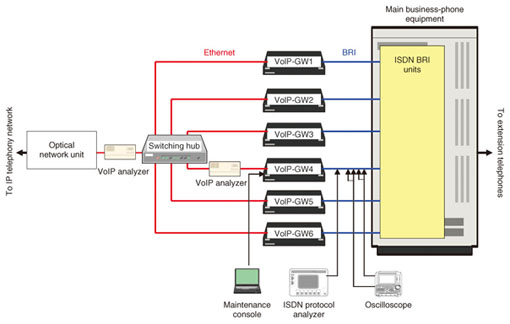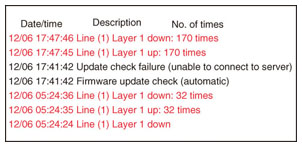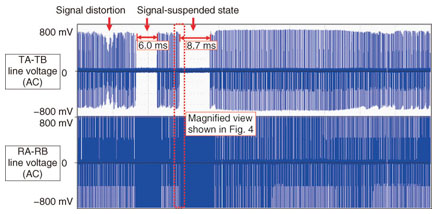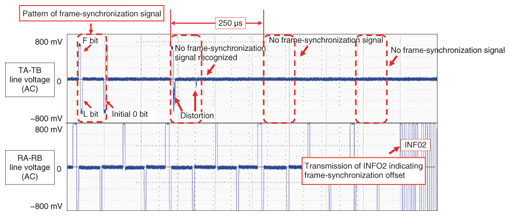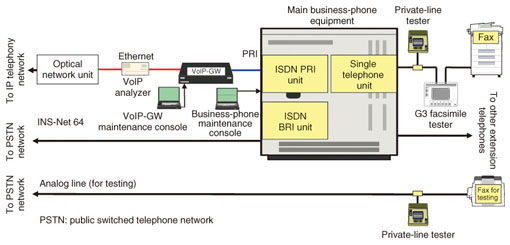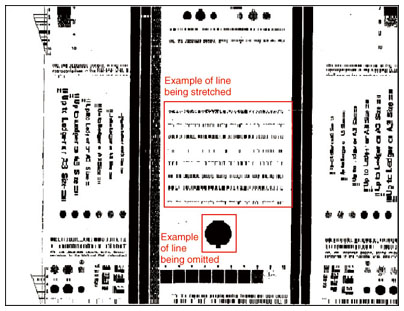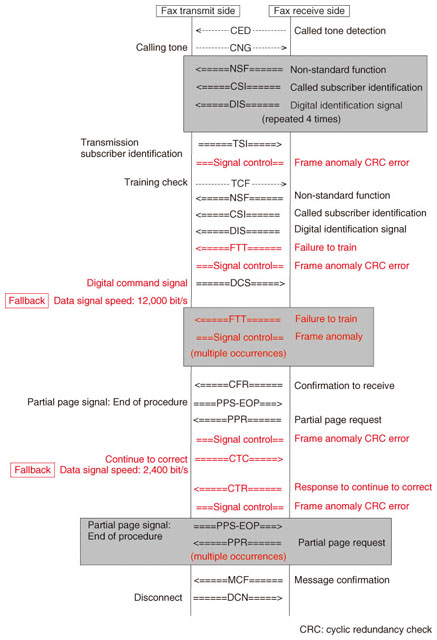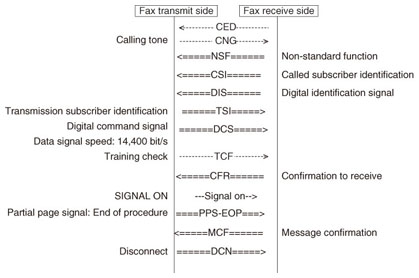 |
|||||||||
|
|
|||||||||
|
Practical Field Information about Telecommunication Technologies Vol. 9, No. 10, pp. 75–80, Oct. 2011. https://doi.org/10.53829/ntr201110pf1 Case Studies of Failures of Business Phones Connected to VoIP GatewayAbstractThis article introduces case studies of failures of business phones connected to a VoIP (voice over Internet protocol) gateway developed by NTT EAST. It is the seventh in a bimonthly series on the theme of practical field information about telecommunication technologies. This month's contribution is from the Network Interface Engineering Group, Technical Assistance and Support Center, Maintenance and Service Operations Department, Network Business Headquarters
1. IntroductionIn parallel with the spread of broadband services, a migration from traditional subscriber telephone services to IP (Internet protocol) telephony is taking place. When a customer who has been using traditional subscriber telephone services changes to IP telephony over existing circuits accommodating business phones, connections to those business phones are made via a VoIP-GW (voice-over-IP gateway). Consequently, the troubleshooting of business phones involves VoIP technologies (e.g., Session Initiation Protocol (SIP) and Real-time Transport protocol (RTP)) used in IP telephony in addition to existing analog and ISDN (integrated services digital network) technologies used in subscriber telephone services. This article presents two case studies of failures that occurred in existing business phones connected to a VoIP-GW. 2. Case studies2.1 Business phone unable to make outgoing/incoming calls(1) Equipment configuration In this example, the customer was using NTT EAST's Hikari Denwa Business Type IP telephony service and had six VoIP-GWs connected to existing business phones. The VoIP-GWs were connected to ISDN basic rate interface (BRI) units in the main business phone unit since the customer had been using NTT EAST's INS-Net 64 service* before the IP telephony service. The equipment configuration is shown in Fig. 1.
(2) Failure description The customer reported that outgoing and incoming calls occasionally could not be made via a certain VoIP-GW. This problem could be resolved by turning the VoIP-GW's power off and then on again or by unplugging and reinserting the cable connected to the BRI units. (3) Inspection details A maintenance console (personal computer (PC)) was used to collect and analyze the failure log from the VoIP-GW in question. An ISDN protocol analyzer was used to monitor the protocol transfers between the VoIP-GW and business phone. An oscilloscope was used to monitor signals in the segment between the VoIP-GW and the ISDN BRI unit (signals between wires TA & TB and RA & RB) and to inspect the noise environment at the time of a failure (e.g., the quality of the commercial power supply and telecommunication lines. VoIP analyzers were used to perform packet capture and analyze captured data in the segment between the optical network unit (ONU) and the switching hub and in the segment between the switching hub and the VoIP-GW (Ethernet sections). (4) Inspection results The VoIP-GW failure log revealed that a "layer 1 down" event occurred many times on the BRI circuit between the VoIP-GW and main business-phone equipment. An excerpt from the log at the time that a failure occurred is shown in Fig. 2. Protocol monitoring using the ISDN protocol analyzer revealed "INFO lost" indicating "layer 1 down" in the same time period as the timestamps of the failures recorded in the VoIP-GW failure log. Signal monitoring between the VoIP-GW and main business-phone equipment revealed signal distortion and signal-suspended states in the signal waveform of the TA-TB line for transmissions from the main business-phone equipment to the VoIP-GW (Fig. 3). At this time, no changes in conduction noise in the commercial power supply or telecommunication lines were detected. Analysis of captured packed data revealed no packets or sequences that could be considered abnormal.
(5) Cause of failure This failure was considered to occur for the following reason. Owing to the distortion and suspended state of the signal transmitted from the business phone (TA-TB line signal), the VoIP-GW could not detect a frame-synchronization signal in three time-frames, which it interpreted as a frame-synchronization offset; this prompted the transmission of an INFO2 signal and the disabling of outgoing and incoming calls (Fig. 4).
(6) Countermeasures and results The ISDN BRI unit connected to the business phone was replaced. This restored the line to normal operation. (7) Summary An analysis of the VoIP-GW failure log revealed that "layer 1 down" events had occurred between the VoIP-GW and business phone, which enabled the cause of this phenomenon to be inferred. Checking failure logs of installed equipment is a relatively simple and important form of troubleshooting. 2.2 Faulty transmission/reception in a fax machine acting as a business-phone terminal(1) Equipment configuration In this example, a customer was using NTT EAST's Hikari Denwa Business Type IP telephony service. The business phones were connected to a single VoIP-GW via the main business phone equipment. They were also connected to INS-Net 64 as a backup circuit. The main business phone equipment contained an ISDN primary rate interface (PRI) unit connected to the VoIP-GW to accommodate the IP telephony service; an ISDN BRI unit to connect to INS-Net 64; and a single telephone unit, which connected to a fax machine acting as an extension business-phone terminal. The equipment configuration is shown in Fig. 5.
(2) Failure description Images transmitted or received by this fax machine were occasionally distorted (lines stretched or omitted) and sometimes faxes could not be transmitted or received. An example of a fax image received at the time of failure is shown in Fig. 6.
(3) Inspection details A G3 (third-generation) facsimile tester was used to monitor the fax communication sequence. A private-line tester was used to measure the bit error rate on the transmission path used for fax communications. A VoIP analyzer was used to capture packets and analyze captured data between the ONU and VoIP-GW (Ethernet interval). Maintenance consoles (PCs) were used to check the data settings in the VoIP-GW and business-phone ISDN interfaces. (4) Inspection results Monitoring of the fax communication sequence by the G3 facsimile tester revealed "failure to train" signals, "frame anomaly" signals, and drop-in-transmission-speed sequences not observed during normal operation. The fax communication sequences at the time of failure and during normal operation are shown in Figs. 7 and 8, respectively. Bit-error measurements revealed a bit error rate of about 4–5% (effective number of bits: 106 in both the uplink and downlink. An analysis of captured packed data revealed no packets or sequences that could be considered abnormal. Data settings in the VoIP-GW's ISDN interface indicated that the synchronization clock was set to slave, meaning that the clock was extracted from other equipment.
(5) Cause of failure This failure was considered to occur because of a mismatch in the setting covering the synchronization clock between the VoIP-GW and the main business phone unit, which led to unstable synchronization between them and degraded the transmission quality and generated defects in the fax communications. (6) Countermeasures and results The VoIP-GW synchronization setting was changed from slave to master so that the clock would be self-generated. This prevented this failure from reoccurring. (7) Summary A bit error rate of about 4–5% on the transmission path used for fax communications affected the quality of fax communications. When the failure occurred, only fax communications, which has strict data-transmission requirements, suffered a drop in quality—no problems such as choppiness could be perceived in voice calls made using other extension (business) phones. 3. ConclusionThis article presented case studies of failures that occurred when the circuits accommodating existing business phones were migrated from traditional subscriber telephone services to IP telephony in a configuration in which business phones were connected to VoIP-GWs. In these case studies, failures that did not occur when using traditional subscriber telephone services occurred when the equipment configuration changed upon migration to IP telephony and upon the addition of new equipment. Both IP technologies and existing analog & ISDN technologies are essential in troubleshooting when VoIP is used with existing business phones. References
|
|||||||||








